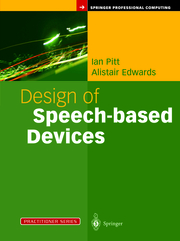Detailansicht
Design of Speech-based Devices
A Practical Guide, Practitioner Series
ISBN/EAN: 9781447110897
Umbreit-Nr.: 4376712
Sprache:
Englisch
Umfang: xi, 179 S., 7 s/w Illustr.
Format in cm:
Einband:
kartoniertes Buch
Erschienen am 03.10.2012
Auflage: 1/2003
- Zusatztext
- Inhaltsangabe1 Introduction.- 1.1 Evolution of Speech Synthesis.- 1.2 Text to Speech.- 1.3 Copy Synthesis.- 1.4 Applications.- 1.5 Applications for Blind People.- 1.6 Limitations of Current Design Methods.- 2 Background and Previous Research.- 2.1 Pausing and Rhythm.- 2.2 Intonation.- 2.3 New versus Given Information.- 2.4 Length of Utterance.- 2.4.1 Primacy and Recency.- 2.4.2 The Modality Effect.- 2.4.3 The Auditory Suffix Effect.- 2.4.4 Summary.- 2.5 Meaning: More than Semantics.- 2.6 Effects of Speech Quality.- 2.7 Summary and Conclusions.- 3 Interaction Design.- 3.1 Differences Between Visual and Auditory Interfaces.- 3.2 User Selection versus Designer direction.- 3.3 Determining Relevance.- 3.4 The Role of Expectation.- 3.5 Giving the Listener Control.- 3.5.1 Mute Key.- 3.5.2 Repeat Key.- 3.5.3 More Information Key.- 3.6 Conclusions.- 4 Dialogue Design.- 4.1 Choosing Speech or Non-speech Presentation.- 4.2 Designing Non-speech Responses.- 4.3 Designing Speech Segments.- 4.4 Major and Minor Sentences.- 4.5 Example of Designing Utterances for an Interactive System.- 4.6 Choice of Phrasing.- 4.7.1 Avoiding Ambiguity.- 4.7.2 Homophones: Words which Sound Alike.- 4.7.3 Words with More than One Meaning.- 4.7.4 Words with More than One Pronunciation.- 4.7.5 Abbreviations.- 4.8 Personality.- 4.8.1 Politeness.- 4.9 Presenting Numbers.- 4.10 Summary.- 5 Presenting Individual Speech Dialogues.- 5.1 Intonation Patterns in Spoken English.- 5.2 Statements.- 5.2.1 Intonation Patterns.- 5.2.2 Rhythm and Stress.- 5.3 Questions.- 5.3.1 Yes/No Questions.- 5.3.2 Alternative Questions.- 5.3.3 "Wh" Questions.- 5.4 Directives.- 5.5 Summary.- 6 Presenting Lists and Menus.- 6.1 Problems Posed by Spoken Lists.- 6.2 Organizing Lists and Menus to Aid Memorization.- 6.3 List Size and Memorability.- 6.4 A Speech-based, List-searching Tool.- 6.5 Using Prosody to Convey Structure and Context.- 6.6 Using Priming Information.- 6.7 Providing Summaries and Overviews.- 6.8 Summary.- 7 Case Studies.- 7.1 Introduction.- 7.2 Evaluation of the Trafficmaster Freeway.- 7.2.1 Operation.- 7.2.2 Requirements.- 7.2.3 Analysis.- 7.2.4 Non-speech Sounds.- 7.2.5 Recommendations.- 7.2.6 Summary.- 7.3 The SpeakEasy NT Voicemail System.- 7.3.1 Picking up Messages.- 7.3.2 Sending Voicemails.- 7.3.3 Leaving Messages.- 7.3.4 Summary.- 7.4 Design of a Speaking Video Recorder Interface.- 7.4.1 Considerations.- 7.4.2 Design.- 7.4.3 Example.- 7.4.4 Implementation.- 7.4.5 Summary.- 7.5 Conclusions.- 8 Future Trends.- 8.1 Introduction.- 8.2 Technology.- 8.3 Speech as an Alternative Channel of Communication.- 8.4 Applications for Users with Special Needs.- 8.5 Speech and Mobile Devices.- 8.6 Avatars.- 8.7 Unsolved Problems and Issues.- 8.8 Conclusions.- Appendix A: List of Homophones.- Appendix B: Words with More than One Meaning.- Appendix C: Words with More than One Pronunciation.- References.
- Kurztext
- Provides practical guidance when designing speech-based systemsIncludes case studies which examine real-life (good and bad) examplesDiscusses the design of speech-based devices - what information should be communicated, and howExplains how information should be presented as speech - what rhythm, pausing and intonation should be usedConsiders current research directions in speech technology, probable future developments and problems that remain unsolved
- Autorenportrait
- Inhaltsangabe1 Introduction.- 1.1 Evolution of Speech Synthesis.- 1.2 Text to Speech.- 1.3 Copy Synthesis.- 1.4 Applications.- 1.5 Applications for Blind People.- 1.6 Limitations of Current Design Methods.- 2 Background and Previous Research.- 2.1 Pausing and Rhythm.- 2.2 Intonation.- 2.3 New versus Given Information.- 2.4 Length of Utterance.- 2.4.1 Primacy and Recency.- 2.4.2 The Modality Effect.- 2.4.3 The Auditory Suffix Effect.- 2.4.4 Summary.- 2.5 Meaning: More than Semantics.- 2.6 Effects of Speech Quality.- 2.7 Summary and Conclusions.- 3 Interaction Design.- 3.1 Differences Between Visual and Auditory Interfaces.- 3.2 User Selection versus Designer direction.- 3.3 Determining Relevance.- 3.4 The Role of Expectation.- 3.5 Giving the Listener Control.- 3.5.1 Mute Key.- 3.5.2 Repeat Key.- 3.5.3 More Information Key.- 3.6 Conclusions.- 4 Dialogue Design.- 4.1 Choosing Speech or Non-speech Presentation.- 4.2 Designing Non-speech Responses.- 4.3 Designing Speech Segments.- 4.4 Major and Minor Sentences.- 4.5 Example of Designing Utterances for an Interactive System.- 4.6 Choice of Phrasing.- 4.7.1 Avoiding Ambiguity.- 4.7.2 Homophones: Words which Sound Alike.- 4.7.3 Words with More than One Meaning.- 4.7.4 Words with More than One Pronunciation.- 4.7.5 Abbreviations.- 4.8 Personality.- 4.8.1 Politeness.- 4.9 Presenting Numbers.- 4.10 Summary.- 5 Presenting Individual Speech Dialogues.- 5.1 Intonation Patterns in Spoken English.- 5.2 Statements.- 5.2.1 Intonation Patterns.- 5.2.2 Rhythm and Stress.- 5.3 Questions.- 5.3.1 Yes/No Questions.- 5.3.2 Alternative Questions.- 5.3.3 "Wh" Questions.- 5.4 Directives.- 5.5 Summary.- 6 Presenting Lists and Menus.- 6.1 Problems Posed by Spoken Lists.- 6.2 Organizing Lists and Menus to Aid Memorization.- 6.3 List Size and Memorability.- 6.4 A Speech-based, List-searching Tool.- 6.5 Using Prosody to Convey Structure and Context.- 6.6 Using Priming Information.- 6.7 Providing Summaries and Overviews.- 6.8 Summary.- 7 Case Studies.- 7.1 Introduction.- 7.2 Evaluation of the Trafficmaster Freeway.- 7.2.1 Operation.- 7.2.2 Requirements.- 7.2.3 Analysis.- 7.2.4 Non-speech Sounds.- 7.2.5 Recommendations.- 7.2.6 Summary.- 7.3 The SpeakEasy NT Voicemail System.- 7.3.1 Picking up Messages.- 7.3.2 Sending Voicemails.- 7.3.3 Leaving Messages.- 7.3.4 Summary.- 7.4 Design of a Speaking Video Recorder Interface.- 7.4.1 Considerations.- 7.4.2 Design.- 7.4.3 Example.- 7.4.4 Implementation.- 7.4.5 Summary.- 7.5 Conclusions.- 8 Future Trends.- 8.1 Introduction.- 8.2 Technology.- 8.3 Speech as an Alternative Channel of Communication.- 8.4 Applications for Users with Special Needs.- 8.5 Speech and Mobile Devices.- 8.6 Avatars.- 8.7 Unsolved Problems and Issues.- 8.8 Conclusions.- Appendix A: List of Homophones.- Appendix B: Words with More than One Meaning.- Appendix C: Words with More than One Pronunciation.- References.
